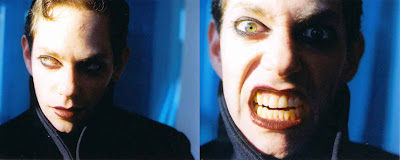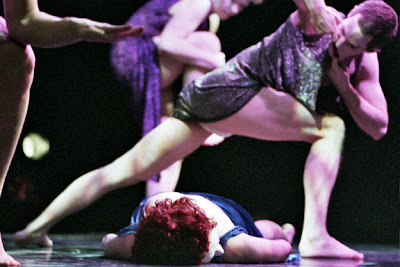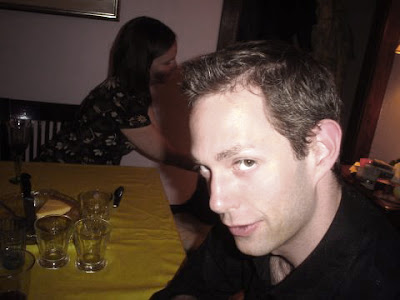 1) What the fuck is going on?
1) What the fuck is going on?
Well, I just returned from a week in Prague, followed by 24 hours in London. I went to Prague to attend the Quadrennial, which was totally fascinating, and I kept randomly running into people I knew. None of the picutres of any of the exhibits turned out, unfortunately. Good thing it was all so memorable.
I’m teaching butoh classes at the Creative Children’s Dance Centre studio, am in the midst of creating a dance piece called Avatars/Ratavas with Lucy Rupert of Blue Ceiling Dance, and in August I’m going to be playing a tarantella-dancing marconi officer on the Titanic in Theatre Rusticle’s April 14, 1912.
Mostly I’m avoiding writing grant applications, and generally revelling in being in Toronto for the summer, which means easy access to my dad, my best friend (Christine Horne) and my favourite café (Dessert Trends).
2) What is butoh?
Butoh is a post-War Japanese dance-theatre form. Its founders, Tatsumi Hijikata and Kazuo Ohno, felt that there was no discipline that could encompass their reaction to having two atomic bombs dropped on their country. Butoh is influenced by many different forms – German Expressionist dance, grotesque Medieval Japanese woodcuts, and the writings of Yukio Mishima among them, and is said to be born of the ashes of Hiroshima and Nagasaki. Hijikata especially focused on the juxtaposition of horrific and sublime imagery, on placing the body in crisis and on highlighting “ma,” the space between events. All of these characteristics culminate to create a dance form which strives to transform time and space for both its practitioners and its audiences.
For me, butoh expresses the general state of terror in which I’ve found myself in the last few years. I became interested in butoh soon after 9/11 and that has deepend as our culture has blithely careened further and further along a highly destructive path. Immediately after 9/11, I got very frustrated at seeing a constant barrage of lukewarm, three-star, polite-applause performances. It was so surreal to go to the theatre and feel that it was in a state of aggressive denial about world events. Seeing butoh in this context was such a relief. It named and explored my own outlook. There was an immediate and persistent kinship with the form.
 3) Ideally, what new insights into their craft would you like stage actors to come away from your butoh workshops with?
3) Ideally, what new insights into their craft would you like stage actors to come away from your butoh workshops with?
Well, first, I hope that not only stage actors will come to my class. I think butoh is useful for artists of all disciplines, as well as the general public. For actors working in any medium though, a butoh class offers a chance to explore imagery as a creative tool. The work is physically challenging (the good old body in crisis), but it also involves a sustained use of myriad images. It is an exercise in mental and creative multitasking to try to hold 15 images in the body simultaneously. Developing this kind of mental, psychological and emotional dexterity, in concert with challenging physicality is pretty exciting to me as an actor. Coordination, physical control and a rock-hard ass are good fringe benefits too.
4) Do you make any clear distinctions between theatre and dance?
Less and less. They used to be clearly delimited by a focus on the body or the text. However, as I delve into more physical theatre, and dance that includes the voice in some way, these distinctions become less relevant. Someone once said to me that artists are nomads between disciplines, and that the concept of a piece should dictate its form. I like this a lot, and it jives nicely with a directive we built into The Thistle Project – that the style of a piece we create should do honour to its source material.
I also believe that butoh exists in other art forms. I consider Kieren MacMillan to be a butoh composer for example, or Tilda Swinton to be a butoh film actor. So what does that say about the exclusivity of the discipline? Ronya Lake, a friend and dance colleague of mine in Vancouver, is rehearsing a piece right now in which she will be digging up sand with her bare hands, on a beach, in front of a sand castle, by the ocean, while 20 paper boats float by. The piece is going to be kick-ass, and it’s going to be butoh, for sure, but there will be no discernable “dance” in it anywhere. Faced with work like that, questions about the discreteness of disciplines become irrelevant.
5) How important is it for theatre artists to be out there seeing lots of shows?
Oh lordy loo. You can’t not do it. Whether you spent three years in a theatre program or not, going to shows acts as a major training ground for a young artist. And as you become more established, I think it prevents you from getting too complacent about your own work. Seeing shows is the only thing that can hone your aesthetic; the only stage on which it’s possible to really test and challenge folks like Judith Butler and Richard Schechner.
I find that sitting in the audience has clarified my artistic goals more than acting on the stage itself. I am, though, an engaged audience member. I attend to a performance so actively that it can cause involuntary spasms and vocalizations. Going to shows MUST be about engaging with the piece on all levels. I also think it’s important to go outside your own discipline. It’s too easy to become enamored of a particular methodology when the creative process in theatre, dance, visual arts, music, media arts and design could be enriched by a little cross-pollination.
6) In making theatre in both Vancouver and Toronto, have you noticed any distinct similarities or differences in the way work gets made in the two cities?
From what I can tell, the processes are very similar. Some choreographers and directors in Vancouver are interested in setting pieces on their performers, while others want to create with them. Same here.
Honestly, I notice greater differences among individual artists in both cities than between the cities, if we’re talking about approach. One thing I do notice though is a greater range in the work ethic in Vancouver. In Toronto, it seems that everyone is working reasonably hard, putting up shows, going to auditions or whatever they’re pursuing. In Vancouver, however, I notice people who talk a LOT about what they’re going to do and never actually do it (this is kind of a cliché), but also people in both theatre and in dance who are completely ferocious in a way that I almost never see in Toronto. Kokoro Dance is like that, and so is Screaming Flea Theatre, to name a couple.
7) Have you learned anything about your mind or body through dance that you wish you could pass along to people who don’t dance?
You can do it! Dancing can put so much physical stress on the practitioner, but the body is waaaaaaaaaaay more resilient than the mind lets us believe, and it’s only discipline that will set you free. Go to class no matter what. It makes everything better. Madness, mayhem, death, and the earth shattering beneath your feet are all cured by a modern class with Barbara Bourget.
8) Are there any new stories being told?
No. The most recent new stuff got said by Ionesco, I think. Let’s just honestly react to the subject matter the world is throwing at us, and let future generations worry about whether our work is revolutionary or not. The surest way to create boring, annoying work is to obsess about its novelty.
 9) What’s happening with The Thistle Project these days?
9) What’s happening with The Thistle Project these days?
I’m avoiding writing grant applications. We’ve had a series of meetings with Erika Batdorf about the next piece, and we’ve hit on it. We’re going to do Peer Gynt. With two people. We’re giving ourselves a long creation process and will produce it in the spring of 2009. I can’t wait. At this point, it’s Christine playing Peer and Sölveig, and me playing everyone else. Video, dance, text, and maybe a puppet or two. It’s going to be spectacular.
10) What do you know now that you wish you knew when you were younger?
Seriousness and silliness don’t preclude one another. My father means well. Write down your grandparents’ stories. Lift with your legs, not your back.
ok, why aren’t i in any of those photos??
“Are there any new stories being told?
No. The most recent new stuff got said by Ionesco, I think. Let’s just honestly react to the subject matter the world is throwing at us, and let future generations worry about whether our work is revolutionary or not. The surest way to create boring, annoying work is to obsess about its novelty.”
good one.
i remember trying to write my first play in undergrad (Capital DAS, starring Praxis Co-AD Simon Rice) and obsessing over how it would be different from anything ever created. I wasted a lot of time that way. Eventually I relented and used a lot of my experiences from summer jobs. It turned out pretty good as far as shoestring budget undergrad productions go. So yeah i agree.
Also a big Ionesco fan having just finished directing The Lesson. But there are a lot of new stories since him (Kushner, Mamet, Churchill are just Americans off the top of my head).
Mike, I have to admit that I can’t really talk about Churchill or Mamet. However, I should qualify my sweeping statement by saying that I’m talking about essential content, not details. I think that Kushner for example is telling old stories from new points of view. Angels in America is a man against the divine and against society and against himself kind of story. I love Kushner with all my heart and soul. And I am grateful that he shifts the actantial model around (holy crap, I just said “actantial model.” Thank you Corrine Rusch-Drutz), but on a structural level, I wouldn’t call his stories new. I suspect the same is true for the other two.
And Christine, there are no pictures of you because visitors to the illustrious Praxis blog can view your gorgeous face at praxistheatre.blogspot.com/2007/01/10-questions-christine-horne.html, and then they get to see how witty you are too.
E.M. Forster makes this distinction between story and plot:
“We have defined a story as a narrative of events arranged in their time-sequence. A plot is also a narrative of events, the emphasis falling on causality. ‘The king died and then the queen died’ is a story. ‘The king died, and then the queen died of grief’ is a plot. The time-sequence is preserved, but the sense of causality overshadows it.”
Whether or not you agree with the language of this statement, I think what Forster is doing – as other narrative theorists have done – is trying to locate the simplest building blocks of narrative. The hope is that once we’ve arrived at the bare bones of what it means to be a story (or to tell a story) we’ll find that there is only a finite number of “stories” to tell – the rest is plot – and somehow the exercise will expose the universality of storytelling.
My sense is that it has to go one of two ways: either there are an endless number of stories, or only a small few.
Not really disagreeing with your statements on this, Matthew, just inspired to continue the conversation. What is it that you see in Ionesco that makes his stories seem new?
Mike, did you just call Churchill American?!
I think it’s the antagonist. Maybe I have some kind of block but in Ionesco, I don’t identify an explicit antagonist that had been identified before that point.
I mean, in Rhinoceros, the antagonist is the rhinoceros. It’s sort of the main character’s apathy too (man against himself), but that doesn’t seem to have any connection to the fact that people keep turning into rhinoceroses. Heh. I haven’t read it in a bajillion years, so I’m basically pulling all this action out of my ass. I agree with Forster, though. I believe that there are a small number of stories to tell, and that’s what’s so exciting to me about Ionesco, is that he seems to have somehow circumvented that, by making the specific antagonist of a story into the “prime” antagonist (as in prime number, if you will, fnar fnar fnar). He’s somehow made the particular events of a plot indivisible into a structural or formal story. Rhinoceros is “man against rhinoceros,” and nothing else. Hm. Someone prove me wrong please. I’m going on [notoriously bad] memory here.
well, a.g. is right. here’s the wikipedia on her background:
Churchill was born in London, England. During World War II her family emigrated to Montreal, Canada, where she attended Trafalgar School for Girls. She returned to England to attend university, and graduated from Lady Margaret Hall, Oxford in 1960 with a degree in English Literature. She also began her career there, writing three plays for performance by student drama groups: Downstairs, You’ve No Need to be Frightened and Having a Wonderful Time.
In 1961 she married David Harter, a lawyer from Oxford, and began raising three sons.
She is a patron of the Palestine Solidarity Campaign.
thanks a.g. i think i just got into my head she was american cause her new show was @ NY Theatre Workshop when I was there.
As for this whole “new stories” stuff, that’s why I bought up the whole Joseph Campbell thing in the last series of posts. Cause there is a good argument to be made that there are are only 7 stories we tell over and over. Man vs man, man vs nature, man vs himself (feminist scholars would have a field day with this, but anyhow). Matthew argues that Ionesco broke the mold by adding an 8th: Man vs Rhinocerous. In any case all that can change is HOW we tell these stories in this context…..
Yet, I think there is a good argument to be made that even if we accept this, telling these stories diferently makes them new. Mashall McLuhan’s maxim “The media is the message” is useful here. The fact that male and female roles are cast cross-gender are just as important as the text of Cloud Nine. A new way of telling stories makes them new stories.
Don’t worry matthew, as a.g. has illustrated, i am just pulling it out of my ass too.
True what you said about shattered earth and Bab’s class :) Speaking of which, I’m going to be late because I became so engrossed in your interview.
Ronya